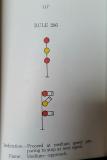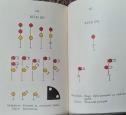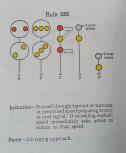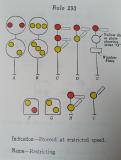
| Home | Open Account | Help | 377 users online |
|
Member Login
Discussion
Media SharingHostingLibrarySite Info |
Nostalgia & History > Railroad Signal QuestionsDate: 09/21/20 21:29 Railroad Signal Questions Author: GTW4611 I have a couple of questions regarding railroad signal history:
-I understand that older signals generally are on the right side of the track they are governing or on a signal bridge above the tracks. I have seen newer signals on both sides of the tracks, when did this change occur? -When did railroads stop using searchlight signals on new CTC installations? When did the railroads first start using the modern safetrain color lights? -Finally, looking at some older pictures and signal rulebooks, it looks like on some railroads, a R/Y on two closely spaced signal heads would be a diverging approach, while a R/Y on two widely spaced heads (I’m sure there’s probably a better term) is a restricting. At some point it looks like this practice ended and the lower yellow was replaced by a lunar or flashing red. When did this change take place and was it drive by some sort of rule change. Thank you, -Michael Date: 09/22/20 08:30 Re: Signal Questions Author: timz RRs had to get some sort of permission to put
signals left of the track until... around 1970? Santa Fe's CTC over Cajon to Barstow circa 1972 as maybe the first to use no-approval-needed (?) field-side signals. That was all searchlight -- guess SP's CTC over Cajon was searchlight circa 1978. Don't recall any searchlight installations later than that, offhand. I doubt that any RR distinguished between wide-spaced red-over-yellow and close-spaced. Red over yellow might be different from red over red over yellow, but spacing alone wouldn't suffice. Date: 09/22/20 11:41 Re: Signal Questions Author: Englewood Not all CTC installations were searchlight signalled.
The type of signal appliance used; searchlight, color light, color position light, semaphore or position light was not determined by the signal system (ABS, CTC, etc.) in use. A few eastern roads, NKP and NYC come to mind, in some circumstances used a large spacing between the top and bottom signal heads on a mast. The distance between the top and bottom heads was the same as in a three head signal. The middle head was missing. Date: 09/22/20 12:28 Re: Signal Questions Author: TAW timz Wrote:
------------------------------------------------------- > RRs had to get some sort of permission to put > signals left of the track until... around 1970? > Santa Fe's CTC over Cajon to Barstow circa 1972 > as maybe the first to use no-approval-needed (?) > field-side signals. My first encounter with left hand signals was Dearborn Station in Chicago. There were a few on the left side for lack of room. They had an additional unit with a lighted L to show that it was a left hand signal. > I doubt that any RR distinguished between > wide-spaced red-over-yellow and close-spaced. > Red over yellow might be different from red > over red over yellow, but spacing alone > wouldn't suffice. > No, however, some had indications associated with staggered units on the mast, one on the right side of the mast and one on the left side of the mast. https://nycshs.org/about-n-y-c/nycs-signal-rules/ TAW Date: 09/22/20 12:35 Re: Railroad Signal Questions Author: cewherry GTW4611 Wrote:
------------------------------------------------------- "....At some point it looks like this practice ended and the lower yellow was replaced by a lunar or flashing red. > When did this change take place and was it drive > by some sort of rule change." Sometime in the 1970's SP changed from a Red/Green aspect to enter a controlled siding to, IIRC, Red/Yellow. On the BN, in the Seattle area the aspect to enter a controlled siding was/is: Red/Lunar. My understanding for the difference was that BN's sidings were not bonded whereas SP's were. Charlie Date: 09/22/20 13:22 Re: Railroad Signal Questions Author: raytc1944 We had some signals on the "other side" back in the 60's on the NYC. We had to get permission from the then ICC to do it.
Date: 09/22/20 13:25 Re: Signal Questions Author: Rathole Oh yes, they sure did, and still do today. On my area of NS (former Southern), a closely spaced red over yellow is a diverging approach. BUT, a red over yellow with a large space in between the signals (enough space for another signal) is a restricting. It makes a major difference.
============================================================================================= timz Wrote: ------------------------------------------------------- > > I doubt that any RR distinguished between > wide-spaced red-over-yellow and close-spaced. > Red over yellow might be different from red > over red over yellow, but spacing alone > wouldn't suffice. > > Date: 09/22/20 13:46 Re: Railroad Signal Questions Author: krm152 CSX has some left handed signals for single track where they used one mast to mount signals for both directions.
ALLEN Date: 09/22/20 17:54 Re: Railroad Signal Questions Author: ExSPCondr Distance between heads couldn't be used as a means of displaying different indications, as an engineer would just have to say "I thought they were far apart," when indeed they were close enough together to be diverging?
Actually the difference in the indication depends upon the operating rules in effect. If the RR is more or less in the Midwest or West, and operating under GCOR, (General Code of Operating Rules) Red over Yellow is Diverging Approach. In NORAC territory, (mostly in the East,) Red over Yellow is Restricting. The discussion of entering sidings under GCOR is as mentioned above, Red over Lunar into non-bonded sidings, AND occupied bonded sidings with a traffic-stick signal relay. This will let a dispatcher line a follow-up movement into an occupied siding, but won't let him or her line two trains into each other. If the siding is clear and bonded, at least on the former SP, the signal will be Red over Yellow. Waaay back, the SP had distant signals in their sidings, about 2/3 of the way down the siding, so a train lined into a clear siding got a Red over Green. Lined into an occupied siding at that time gave a Red over Yellow. When they took out the distant signals, they left the Red over Green indication until the FRA got on them about it. Now its Red over Yellow into a clear siding, and Red over Lunar into an occupied siding. The BNSF will tell you going in if you are lined out, in other words if you get a Red over Green, you're lined out with at least a Flashing Yellow There is a track circuit something like 1500 feet on each end, when occupied prevents the dispatcher from clearing a Red over Lunar. On the former WP they had to bond the sidings on the Mountain, because the trains had to go so slow around curves that they never got over the road. The WP signal computer "remembers" that there is a train in a siding until it is lined out the other end, and won't let the dispatcher line another Lunar into a siding that hasn't had a train lined out of it. G Date: 09/23/20 05:09 Re: Railroad Signal Questions Author: Englewood A few minutes searching google for "NS Operating Rule book" found the 2015
issue which confirms Rathole's statement. Look at rules 347 fig. B and 348 fig. B Diverging Approach vs. Restricting. Only difference is spacing between signal heads. May not be what you grew up with but not all railroads have the same signal rules. Date: 09/23/20 07:43 Re: Railroad Signal Questions Author: TAW Englewood Wrote:
------------------------------------------------------- > May not be what you grew up with but not all > railroads have the same signal rules. Dim memory of a rule book library in boxes in a storage unit tells me that at one time, the bottom unit what is now of a two or three unit signal was a pot (dwarf) standing in front of or next to the main signal mast. The term 'All red' that we use for a red signal is not related to how red it is but rather to all of the signals that apply to us are red, dating from when part of ths indication was a pot or when the units on the mast were considered separate signals. I mechanical machines with mechanical semaphores, each of the units of a multiple-arm signal were separate levers in the machine. TAW Date: 09/23/20 14:57 Re: Railroad Signal Questions Author: halfmoonharold I had scanned these for an earlier post I was planning, but never got around to. Nickel Plate medium approach vs. restricting, 1943 rule book.
  Date: 09/23/20 15:00 Re: Railroad Signal Questions Author: halfmoonharold Now here are the N&W aspects, from their first post-merger rulebook of 1967. Note the former Wabash aspects, using a lunar vs. red for the top aspect. Doesn't seem very safe, in retrospect. A cracked red lens would appear white, and would then become a LESS-restrictive aspect.
Edited 1 time(s). Last edit at 09/23/20 15:03 by halfmoonharold.   Date: 09/23/20 17:10 Re: Railroad Signal Questions Author: wabash2800 As someone may have mentioned earlier, there were cases of signals (the exception) on the opposite side of the track because of visibilty or other issues. This photo was taken at Crocker, Indiana in the 1940s and here we have two examples. The track at left on the EJ&E Porter Branch has the semaphore home signal (not the train order signal across from the tower) on the opposite side of the track because of the siding and the fact there was no cantilever signal bridge option or the RRs didn't want to spend money on a bracketed signal mast.* The Wabash to the right has a semaphore home signal on the right side of the track but with the signal arms on the wrong side! This apparently was because the coaling machine obstructed the view of home signal blades on the right side of the track. I don't know if special permission was needed from the ICC.
When I first saw this photo, I thought it was printed backwards and we discussed it here and it was not. Incidentally, I don't know when they started the practice, but the Wabash had some searchlight block signals (and color light?) signal heads that were mounted on the same signal mast for opposite directions. There is (or was) an example east of New Haven, Indiana on the former Wabash main to Detroit. * Edit: When I look at the EJ&E track set-up, there appears to be three tracks and a bracketed signal mast would have been in the cornfield. Victor A. Baird http://www.erstwhilepublications.com Edited 3 time(s). Last edit at 09/23/20 17:17 by wabash2800.  |